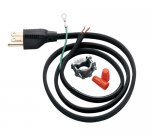The NEC allows in certain cases a cord and plug to be used as the disconnecting means. See the following code sections for more information;
422.16 Flexible Cords.
(A) General. Flexible cord shall be permitted (1) for the connection of appliances to facilitate their frequent interchange or to prevent the transmission of noise or vibration or (2) to facilitate the removal or disconnection of appliances that are fastened in place, where the fastening means and mechanical connections are specifically designed to permit ready removal for maintenance or repair and the appliance is intended or identified for flexible cord connection.
(B) Specific Appliances.
(1) Electrically Operated Kitchen Waste Disposers. Electrically operated kitchen waste disposers shall be permitted to be cord-and-plug-connected with a flexible cord identified as suitable for the purpose in the installation instructions of the appliance manufacturer, where all of the following conditions are met:
(1) The flexible cord shall be terminated with a grounding-type attachment plug.
Exception: A listed kitchen waste disposer distinctly marked to identify it as protected by a system of double insulation, or its equivalent, shall not be required to be terminated with a grounding-type attachment plug.
(2) The length of the cord shall not be less than 450 mm (18 in.) and not over 900 mm (36 in.).
(3) Receptacles shall be located to avoid physical damage to the flexible cord.
(4) The receptacle shall be accessible.
(2) Built-in Dishwashers and Trash Compactors. Built-in dishwashers and trash compactors shall be permitted to be cord-and-plug-connected with a flexible cord identified as suitable for the purpose in the installation instructions of the appliance manufacturer where all of the following conditions are met:
(1) The flexible cord shall be terminated with a grounding-type attachment plug.
Exception: A listed dishwasher or trash compactor distinctly marked to identify it as protected by a system of double insulation, or its equivalent, shall not be required to be terminated with a grounding-type attachment plug.
(2) The length of the cord shall be 0.9 m to 1.2 m (3 ft to 4 ft) measured from the face of the attachment plug to the plane of the rear of the appliance.
(3) Receptacles shall be located to avoid physical damage to the flexible cord.
(4) The receptacle shall be located in the space occupied by the appliance or adjacent thereto.
(5) The receptacle shall be accessible.
(3) Wall-Mounted Ovens and Counter-Mounted Cooking Units. Wall-mounted ovens and counter-mounted cooking units complete with provisions for mounting and for making electrical connections shall be permitted to be permanently connected or, only for ease in servicing or for installation, cord-and-plug-connected.
A separable connector or a plug and receptacle combination in the supply line to an oven or cooking unit shall be approved for the temperature of the space in which it is located.
(4) Range Hoods. Range hoods shall be permitted to be cord-and-plug-connected with a flexible cord identified as suitable for use on range hoods in the installation instructions of the appliance manufacturer, where all of the following conditions are met:
(1) The flexible cord is terminated with a grounding-type attachment plug.
Exception: A listed range hood distinctly marked to identify it as protected by a system of double insulation, or its equivalent, shall not be required to be terminated with a grounding-type attachment plug.
(2) The length of the cord is not less than 450 mm (18 in.) and not over 900 mm (36 in.).
(3) Receptacles are located to avoid physical damage to the flexible cord.
(4) The receptacle is accessible.
(5) The receptacle is supplied by an individual branch circuit.
422.33 Disconnection of Cord-and-Plug-Connected Appliances.
(A) Separable Connector or an Attachment Plug and Receptacle. For cord-and-plug-connected appliances, an accessible separable connector or an accessible plug and receptacle shall be permitted to serve as the disconnecting means. Where the separable connector or plug and receptacle are not accessible, cord-and-plug-connected appliances shall be provided with disconnecting means in accordance with
422.31.
(B) Connection at the Rear Base of a Range. For cord-and-plug-connected household electric ranges, an attachment plug and receptacle connection at the rear base of a range, if it is accessible from the front by removal of a drawer, shall be considered as meeting the intent of
422.33(A).
(C) Rating. The rating of a receptacle or of a separable connector shall not be less than the rating of any appliance connected thereto.
Exception: Demand factors authorized elsewhere in this Code shall be permitted to be applied to the rating of a receptacle or of a separable connector. 


